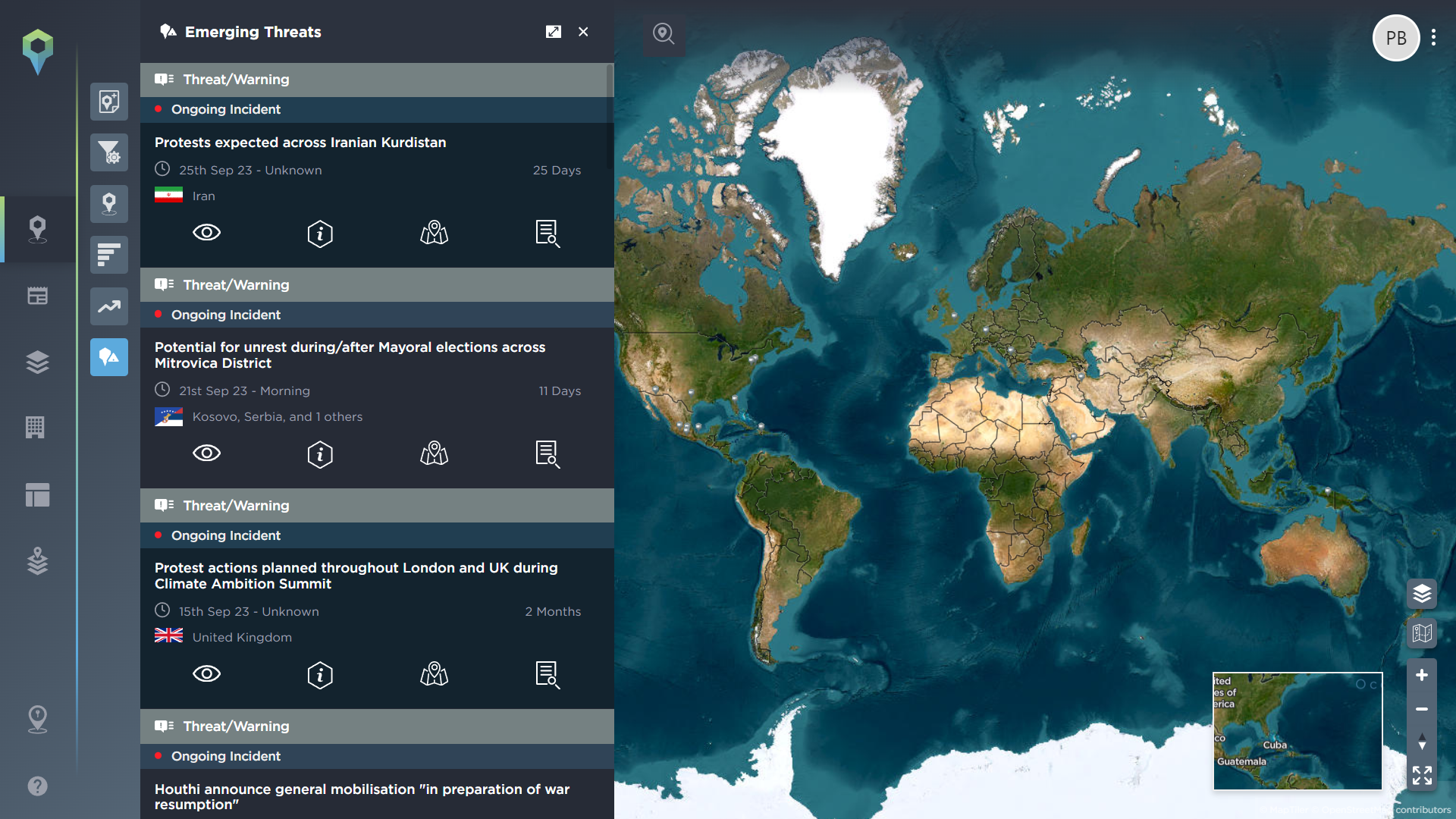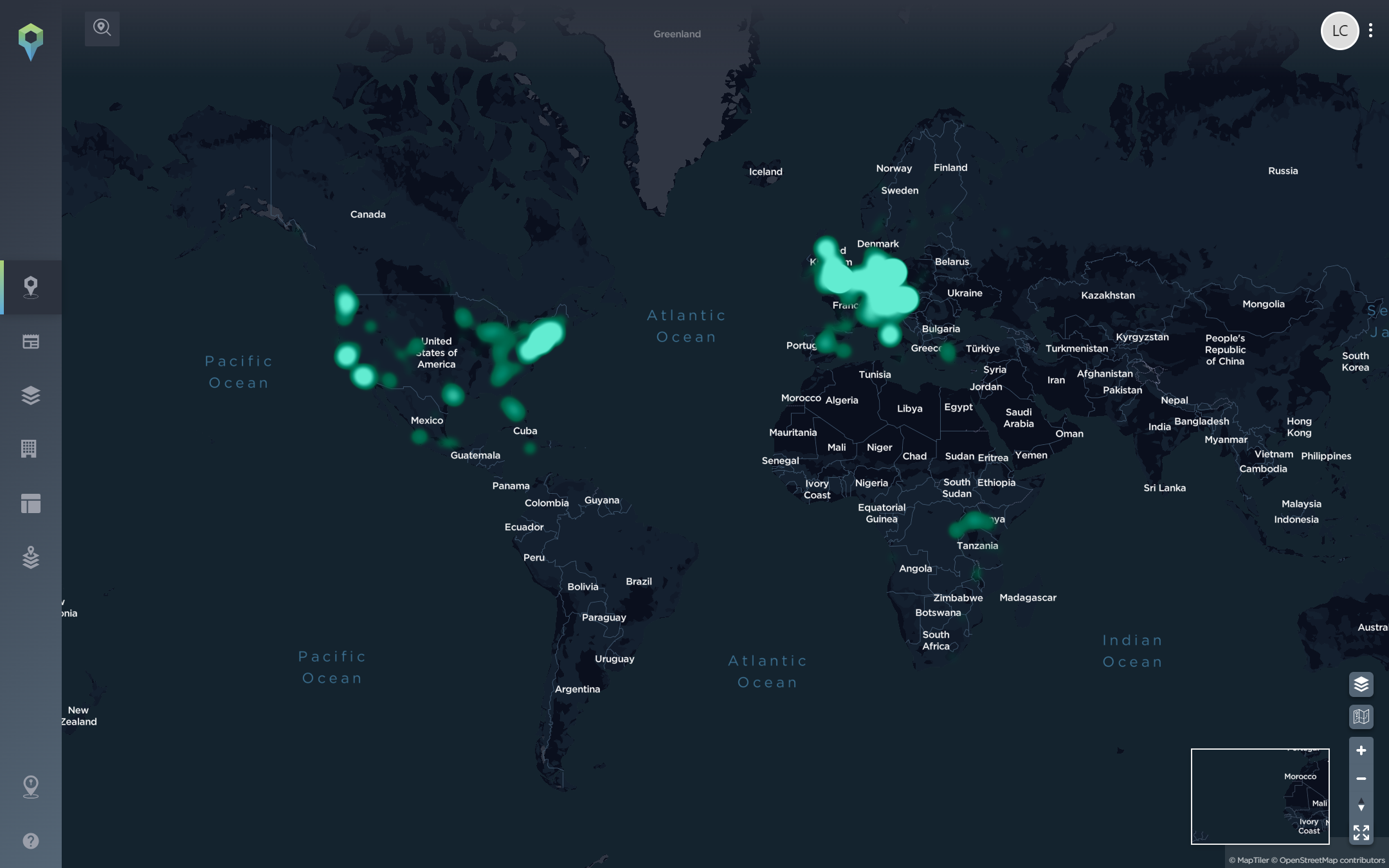2024 Business Threat Predictions
2024 is fast approaching and with the past 12 months featuring mass unrest, violence, war, and political instability, what will the next 12 months have in store?
Our Senior Regional Analysts have shared their predictions for the regions they analyse. They monitor the global threat landscape on a 24-hour basis, and with diverse backgrounds and experiences, the multi-lingual team are best positioned to offer assessments about current and future geopolitical threats that may impact your industry or your organisation directly. The future can never be predicted with absolute certainty, but with historical data and experienced analyst insights, security professionals can plan for the worst-case scenario and be more proactive.
Reviewing data on the Intelligence Fusion platform throughout 2023 reveals that we have mapped over 200,000 incidents so far this year, and the most affected sectors were Police and Law, followed by Transport and Logistics. Extensive filtering options, including advanced tools such as asset mapping and geofencing, can facilitate the identification of trends and patterns relevant to your business; you can even drill down into your specific areas of operation. Book a demo of our platform to see trends and insights.
Below is an overview of our future predictions for the global security landscape, highlighting key issues across each region.
East Asia
Analyst: Alex Smith
Myanmar Junta unlikely to survive 2024
Even before the combined offensives by resistance groups began “Operation 1027” in late October the Junta’s grip on much of the country was weak. Since the military overthrew the newly elected government on 1st February 2021 it has struggled to contain not only the Ethnic Armed Groups (EAG) with which it has been fighting off and on for decades, but also a surprise resistance movement in the Burmese heartland that has overstretched and eroded the military. The past year has seen the Junta forces reduced to manning small garrisons and increasingly reliant on artillery and airstrikes. The Brotherhood Alliance launched a well-planned and coordinated attack on Junta forces in Northern Shan State and has overrun an estimated 150 military outposts. Along with similar campaigns launched by Karen groups and the end of the ceasefire with the Arakan Army (AA) in Rakhine, late 2023 may be a turning point in the war against the Junta, and there have already been some signs that senior Junta figures may be preparing to flee Myanmar.
It is difficult to say for sure if the Junta will fall soon, but there is an increasing possibility that the military regime will not survive the coming year. It certainly seems highly unlikely that the army will mount a campaign to retake the lost territories, and the Junta may be forced to consolidate its forces in central Myanmar. The other question is the true intentions of the EAGs, such as the Myanmar National Democratic Alliance Army (MNDAA). While there is hope that the alliance formed between the National Unity Government (NUG) and various EAGs will lead to a democratic, federal Myanmar it seems far more likely that these groups will fall to fighting amongst themselves as the Junta collapses. The MNDAA, for example, is far from being the spearhead of a democratic movement (despite its name), and it could well be intent on settling scores and reclaiming territories lost in previous conflicts with the military.

Incidents related to the Myanmar Junta [Image source: Intelligence Fusion]
South Asia
Analyst: Max Taylor
Afghanistan’s relations with neighbouring states expected to worsen throughout 2024
2024 will see relationships between the Taliban and neighbouring states deteriorate, with neighbouring states expressing concern over the Taliban’s inability to prevent cross-border insecurity and the Taliban’s push to develop water management projects.
In the case of cross-border insecurity, various militant groups continue to be present in Afghanistan, whether they are aligned with the Afghan Taliban such as Tehreek-I-Taliban Pakistan (TTP) or opposed in the form of Islamic State – Khorasan Province (ISKP). The TTP has carried out and will continue to carry out regular attacks in Pakistan, with the volume and scale of attacks increasing since the Taliban takeover. Despite promises made by the Afghan Taliban, the TTP continues to utilise Afghan soil to harbour fighters and prepare attacks. The continued attacks carried out by the TTP have placed strain on the relationship between the Taliban and Pakistan, with other issues such as the deportation of Afghan refugees from Pakistan further worsening the relationship.
Elsewhere, the presence of ISKP and the Taliban’s capacity to counter them has concerned all of Afghanistan’s neighbours, particularly Afghanistan’s northern neighbours. ISKP has made concerted efforts to increase recruitment among ethnic Tajiks and Uzbeks and has also carried out limited cross-border attacks.
Lastly, water management projects carried out by the Taliban will also serve to strain the Taliban’s relationships with neighbouring states. The Qush Tepe Canal project in the north of the country intends to divert water away from the Amu Daya River, which also serves as an important water source for Central Asian agricultural areas.
Going forward, neighbouring states are expected to pursue diplomatic options rather than military intervention in response to such issues. Nevertheless, the Taliban are not expected to sever their relationship with the TTP, nor are they expected to cease construction of contentious projects such as the Qush Tepa Canal project. Without addressing the causes of tensions between Afghanistan and neighbouring states, the Taliban risks forcing these states to take more hardline stances towards the Taliban government, raising the risk of political dispute and even limited physical clashes along Afghanistan’s borders.
Europe
Analyst: Matt Pratten
Escalation of Ukrainian Tactics and Russian Strategy
The Russia-Ukraine War is expected to escalate and will see Russia take advantage of its strengths in missiles, drones, and airpower to target Ukrainian infrastructure throughout the winter; Ukrainian forces will be limited to defending against these attacks and holding their positions until Spring arrives. Russia will simultaneously carry out actions to break international support for Ukraine which will include – but not be limited to – cyberattacks on governments, ports, banks of Ukraine supporters as well as encouraging its allies/supporters to create unrest (Belarus’ human trafficking efforts especially).
When Spring arrives, this will see Ukraine carry out offensives to push through Russian defenses; with a particular focus on cutting lines of communication between Crimea and the Donbas region. Any successes by Ukraine will likely see Russia carry out mass casualty attacks designed to divert public attention away from Ukrainian successes in order to deny any potential tactical victories from becoming strategic gains.
However, should international support for Ukraine become stronger and/or should Ukraine begin to threaten Russia’s hold on Crimea, Russia may seek to actually employ its ‘escalate to de-escalate’ doctrine. When considering its recent withdrawals from the CTBT (ban on nuclear weapons tests) and the CFE treaty (limits on the size of armed forces), an ‘escalate to de-escalate’ strategy could mean a rapid increase in forces or the potential threat/use of nuclear weapons.

Recent incidents related to the Russia-Ukraine war [Image source: Intelligence Fusion]
Middle East
Analyst: Peter Wood
Houthis Poised to Target Global Shipping, Prompting US Marine Deployment
The war between Israel and Hamas will continue but not in the same manner. Israel will win the military conflict but without serious outside diplomatic pressure to resolve the issue, the conflict will morph into an occupation with low-intensity conflict. This will continue to be a rallying call throughout the region for both ordinary civilians and hostile armed groups.
As Hamas will be severely diminished and Iran is unwilling to risk Hezbollah, the Houthis will be the preeminent force used against Israel. They will continue to pose a threat to the Bab al Mandab Strait as they have already with their hijacking of vessels linked to Israel. At the time of writing, we’ve seen one Israeli-linked vessel seized by Houthis with the group also firing missiles at a US military ship in a different incident.
Hijacking attempts will be most common, and a number of foreign vessels will be considered targets due to even minimal links to Israel and Israeli figures. With this threat, we’ll see the enactment of the US plan to place marines on commercial vessels. This plan was envisaged for the Strait of Hormuz but we’ll now likely see it for the Bab al Mandab Strait.
These hijacking attempts will continue but with a hardening of targets and the presence of a missile arsenal, we might then see the Houthis resort to outright attacks on vessels. Given the importance of shipping through the Red Sea with 26,000 vessels transiting a year, this will severely damage the global economy. While the Houthis don’t have the same capacity, the effects may be similar to the Tanker War in the 1980s and with this threat, insurance premiums will be raised higher due to the risk of life and of the vessels themselves.
Given their survivability, it is unlikely that the Houthis will fear military reprisal and if the US or Israel were to strike the group, it is unclear how effective these strikes would be.
Unlike some other Iranian-aligned groups, Houthi forces often announce their actions beforehand much like they did with their recent hijackings.
Africa
Analyst: Rebecca Egan
Anticipating Surge in Political Tension and Crime in South Africa’s 2024 Polls
In South Africa, the provincial and national elections are scheduled to take place in 2024, but the dates have yet to be confirmed. Political tension has already started to rise with the Democratic Alliance (DA) running a campaign to unseat the African National Congress (ANC) and the possible coalition with the Economic Freedom Fighters (EFF). If a coalition between the ANC and EFF does occur we are likely to see an increase in political tension, due to the clashing ideology of the parties. In March of 2023, the EFF demanded the resignation of President Ramaphosa, solidifying the tensions between these parties.
In the months leading up to the elections, there is a possibility of youth groups and civilians rallying together to encourage voters to go to the polls. Rallying is likely to cause an increase in political tensions which may lead to clashes between different political party supporters. An increase in political propaganda may result in discontent within communities, due to the ongoing issues that the country faces, such as load shedding and damaged water infrastructure. During the election period, the likelihood of politically motivated crimes will increase, with support groups possibly boycotting and protesting outside of polling stations. Regardless of the electoral results, there is a likelihood of protests, looting, and violence. Political tensions have been an ongoing point of contention within South Africa, with allegations of the DA and the EFF being associated with racism and classism. Supporters of the ANC are likely to continue to vote for the party, due to voter loyalty that is associated with apartheid.
Earlier in 2023, a ‘national shutdown’ was organised by the EFF, and there is the potential that another shutdown may be called in 2024. If the violence does escalate following the elections, the business and logistics sectors will be impacted, with stores being looted and road blockades being erected along major roads connecting major metropolitan areas. In the event of large-scale protests, the government is likely to deploy the military to disperse large crowds, which can result in fatalities. In previous politically motivated protests, parties and support groups have been known to release a call to action, encouraging people to take to the streets.

Political demonstrations in South Africa [Image source: Intelligence Fusion]
The Americas
Analyst: Marta Garcia Ruiz
Anticipating Political Violence Surge in the United States Amidst 2024 Election Uncertainties
The escalation of political violence in the United States is anticipated in connection with the highly contentious 2024 Presidential election, especially with Donald Trump embroiled in a multitude of legal complexities encompassing both civil and criminal matters.
The predominant course of action appears to involve an increasing focus on the Supreme Court, which is assuming a more prominent role in policymaking amid escalating divisiveness in the United States. The conservative orientation of the court is expected to exert substantial influence during the 2024 election cycle, contributing to a climate of protracted decision-making characterized by ongoing court rulings and appeals.
The stagnation in American politics is further illustrated by the majority vote ejecting House Speaker Kevin McCarthy and the previous threat of a government shutdown in 2023, contributing to a perceived absence of effective governance. While incidents of both human targets and infrastructure attacks by lone wolves and activists persist, there is no pronounced surge anticipated in 2024.
Conversely, the most dangerous course of action stems from the mistrust of democratic processes and citizens showcasing their discontentment via violence. The occurrence of an unforeseen event, such as a terrorist attack, insurrection, or foreign conflict, has the potential to exacerbate existing sociopolitical, ethnic, or religious divergences. Contrary to prior expectations, instances of property damage and attacks against individuals (ideologically driven) do not witness a decline in numbers. This unfavourable trend prompts the declaration of a national emergency, heightening concerns and posing significant challenges to public safety and security.

Political incidents linked to the 2024 election [Image source: Intelligence Fusion]
Each region faces unique challenges driven by topics such as the political climate, climate change, active conflict, social unrest, and more. The assessments above give an indication of some of the many emerging threats from across the globe that impact a multitude of industries and communities.
Horizon scanning is an essential tactic used by security professionals to analyse emerging threats and pre-empt disruption. The Intelligence Fusion platform has 159 different incident types showing the scale of threats mapped across categories. There are over 1 million historical incidents on the platform, and our team of analysts add over 20,000 new incidents every month. This comprehensive data feed can provide a rich source of information to support security teams, allowing them to make decisions with confidence.
To discover more about our predictions, sign up for our panel discussion with leading security experts discussing what the changing threat landscape actually means for their role, their teams, and their operations.



